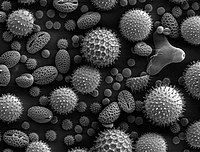
Photo from wikipedia
To harvest two triplet excitons of singlet fission (SF) via a two-electron transfer efficiently, the revelation of the key factors that influence the two-electron-transfer process is necessary. Here, by using… Click to show full abstract
To harvest two triplet excitons of singlet fission (SF) via a two-electron transfer efficiently, the revelation of the key factors that influence the two-electron-transfer process is necessary. Here, by using steady-state and transient absorption/fluorescence spectroscopy, we investigated the two-electron-transfer process from the two triplet excitons of intramolecular SF (iSF) in a series of tetracene oligomers (dimer, trimer, and tetramer) with 7,7,8,8-tetracyanoquinodimethane (TCNQ) as an electron acceptor in solution. Quantitative two-electron transfer could be conducted for the trimer and tetramer, and the rate for the tetramer is faster than that for the trimer. However, the maximum efficiency of the two-electron transfer in the dimer is relatively low (∼47%). The calculation result of the free energy change (ΔG) of the second-electron transfer for these three compounds (-0.024, -0.061, and -0.074 eV for the dimer, trimer, and tetramer, respectively) is consistent with the experimental observation. The much closer ΔG value to zero for the dimer should be responsible for its low efficiency of the two-electron transfer. Different ΔG values for these three oligomers are attributed to the different Coulomb repulsive energies between the two positive charges generated after the two-electron transfer that is caused by their various intertriplet distances. This result reveals for the first time the important effect of the Coulomb repulsive energy, which depends on the intertriplet distance, on the two-electron transfer process from the two triplet excitons of iSF.
Journal Title: Journal of the American Chemical Society
Year Published: 2022
Link to full text (if available)
Share on Social Media: Sign Up to like & get
recommendations!